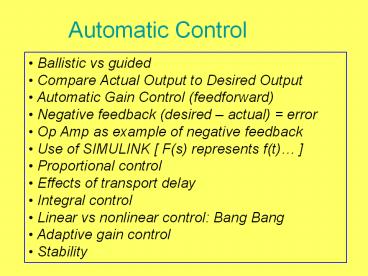Automatic Control - PowerPoint PPT Presentation
Title:
Automatic Control
Description:
Automatic Control Ballistic vs guided Compare Actual Output to Desired Output Automatic Gain Control (feedforward) Negative feedback (desired actual) = error – PowerPoint PPT presentation
Number of Views:601
Avg rating:3.0/5.0
Title: Automatic Control
1
Automatic Control
- Ballistic vs guided
- Compare Actual Output to Desired Output
- Automatic Gain Control (feedforward)
- Negative feedback (desired actual) error
- Op Amp as example of negative feedback
- Use of SIMULINK F(s) represents f(t)
- Proportional control
- Effects of transport delay
- Integral control
- Linear vs nonlinear control Bang Bang
- Adaptive gain control
- Stability
2
Feedforward?
- Is there subtraction of actual from desired?No,
its then subtracted from now - Consider delay in one path differentiation
- AGC Automatic Gain Control
- Or noise subtracted from signalnoise
- Examples Fetal heart monitorMuffler-less
exhaust noise cancellation
_
Delay line
3
Negative feedback
4
Automatic Control vs Homeostatics Automatic
control is imagined to be carried out by sensors
that transduce physical data into voltage
control itself is achieved by motors, heaters,
pumps, and other electromechanical devices. To
account for sensing and control by biological
tissue and organs, physiologists use the term
homeostatis. It implies that important
physiological parameters need to be kept in
limited, static ranges, by means of negative
feedback.
- Blood presssure (vessel dilation)
- Blood sugar (insulin)
- Potassium ions (actions in kidney)
- Pupil diameter of the eye (light level, emotion)
- Sense of balance (vestibular apparatus)
- Temperature (metabolism, cooling by evaporation)
- Stretch reflex (golgi tendon organs)
- Intracellular cyclic GMP (phosphodiesterase
enzyme activity)
5
Negative feedback output as a function of IN and
G(S) Below G(ain) Plant Compensation
(control)
Output is less than open loop but insensitive
to changes in G, if G gtgt 1. G is an internal
factor
6
Negative feedback with dynamics in F(s)(the
problem of algebraic loops)
Let G be a large algebraic gain the only
dynamics is in F(s)
Generating the inverse of a functionuse in
linearizing a complex machine (motor)
7
- Increase speed of response of LP filter with
negative feedback
And see fold23/SpeedChangeLPHP13.m for speed of
HP filter in feedback
Deriving exp(at) Laplace transform
www.biomathdynamics.com
8
Second order plantSpeed increase with
feedback as gain increases it becomes
underdamped.
9
- Reduced sensitivity to changes in Load
10
suppose the load changes suddenly, at t0, from
0 to 2 a step of magnitude 2
instead of 2.0
11
(No Transcript)
12
- Stabilize a system
open loop responsethen place in (unity)
negative feedback system
Let the input be an impulse function with L(d(t))
1
13
Virtues of negative feedback
- system less sensitive to internal parameter
changes - can be used to generate inverse to a transfer
function - system less sensitive to external parameter
changes - increase system speed
- help stabilize an unstable system
- What youve seen here is PROPORTIONAL
controlControl effort proportional to error
14
Vestibular Nystagmus as a marker of velocity
storage
- http//www.youtube.com/watch?vjAE1hr_cLFw
Notice quick phase of VN
Paroxysmal alternating skew deviation and
nystagmus after partial destruction of the
uvula A Radtkea, A M Bronsteina, M A Grestya, M
Faldona, W Taylorb, J M Stevensb, P Rudgea
15
- A use for positive feedback loop gain less
than one
16
Example of a positive feedback loop inside a
negative loopVelocity storage in the VOR and
optokinesis
Lcturs/vstopt05
17
First Top is increased by X4 with 0.75 gain
feedback then when the lights are turned on it
reverts back to faster than normal
18
Example of feedback quiz
- http//www.brown.edu/Departments/Engineering/Cours
es/En123/Exams/FDBKquizes/FDBK06y.htm
19
(No Transcript)
20
Push-Pull Amplifier modelling vestibular
recurrent inhibition
21
Example of op amp NGSA feedback
- http//www.brown.edu/Departments/Engineering/Cours
es/En123/Lectures/FDBKopamp.htm
22
Transport delay
- Flip side of conduction velocity
- A nonlinear Laplace transform
23
approximating transport delay
24
Transport delay of a leaky integrator
And see fold23/TransDly13.mdl
25
Integral compensation drives the error to zero
26
(No Transcript)
27
(No Transcript)
28
PID control for inverted pendulum balance
- Derivative compensation predictive, but a way to
amplify noise in system - Motion-sensitive g-cells at retinal output
- see PoleSim_PID.mdl in work/PoleBal_10
- try modifying the D on PID?more D, better score.
- fold23/PID_first_ord12.mdl
- Approx deriv in Simulink (s)/(sa) at low
freqagtgtsj?http//www.mathworks.com/help/simulin
k/slref/derivative.html
29
Bang bangwhere is the feedback?
- Bang-bang controller forThe Fan Lab in LabVIEW
- Always allowing the actual to drift between
HI-LO limits
30
Simulink and SR latch for bang-bang oscillator
31
Adaptive Gain Control of VOR
- neural network adapting to visual disturbance of
VOR Robinson JNP 1976 - http//jn.physiology.org/content/39/5/954.abstract
?ijkey127029d171b72a8dc8037f9bbcc8abb6ed3863c8ke
ytype2tf_ipsecsha - 122JDD/Asgn06/II_VORgainMOD.htm
- C/MatlabR12/work/fold22/asg5B04.mdl
- B. Widrow Peter N. Stearns, Adaptive Signal
Processing (1985)
32
Adaptive Gain ControlLearning to be a D?A
converter
- We, the designers of a D?A converter, figured out
that resistors of size 1K, 2K, 4K and 8K would be
required for a 4-bit conversion. - Think of the resistances as representing gain
blocks of 1, 2, 4, 8 for LSB to MSB inputs. - Can the weight be learned, by training?
- See code in script
- C/MatlabR12/work/fold23/D2A_learn_2010.m
- The weights start at random then are updated on
each presentation of a learning stimulus/response
pair. - ?W(i) input(i) error e learning rate µ
Hebbs Law
33
Fuzzy Controllers
- See description of Matlab Fuzzy Logic Toolbox
- http//www.mty.itesm.mx/dtie/centros/csi/materias/
ia4002-1/docs/Fuzzy_Toolbox.pdf - Application Examples Inverted pendulum
balancingnoise cancellationbacking up
tractor-trailer truck to loading dockball
juggling































